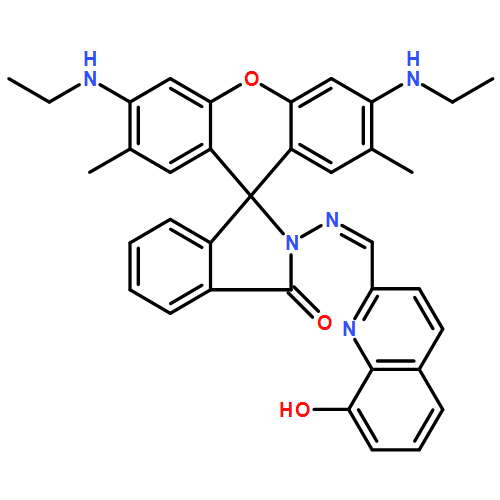Co-reporter: Narendra Reddy Chereddy, Sathiah Thennarasu and Asit Baran Mandal
pp: 11753-11759
Publication Date(Web):26 Jul 2012
DOI: 10.1039/C2DT31316B
Two new rhodamine based probes 1 and 2 for the detection of Fe3+ were synthesized and their selectivity towards Fe3+ ions in the presence of other competitive metal ions tested. The probe 1 formed a coloured complex with Fe3+ as well as Cu2+ ions and revealed the lack of adequate number of coordination sites for selective complexation with Fe3+. Incorporation of a triazole unit to the chelating moiety of 1 resulted in the probe 2, that displayed Fe3+ selective complex formation even in the presence of other competitive metal ions like Li+, Na+, K+, Cu2+, Mg2+, Ca2+, Sr2+, Cr3+, Mn2+, Fe2+, Co2+, Ni2+, Zn2+, Cd2+, Hg2+ and Pb2+. The observed limit of detection of Fe3+ ions (5 × 10−8 M) confirmed the very high sensitivity of 2. The excellent stability of 2 in physiological pH conditions, non-interference of amino acids, blood serum and bovine serum albumin (BSA) in the detection process, and the remarkable selectivity for Fe3+ ions permitted the use of 2 in the imaging of live fibroblast cells treated with Fe3+ ions.
Co-reporter: Narendra Reddy Chereddy, Sathiah Thennarasu and Asit Baran Mandal
pp: NaN11759-11759
Publication Date(Web):2012/07/26
DOI: 10.1039/C2DT31316B
Two new rhodamine based probes 1 and 2 for the detection of Fe3+ were synthesized and their selectivity towards Fe3+ ions in the presence of other competitive metal ions tested. The probe 1 formed a coloured complex with Fe3+ as well as Cu2+ ions and revealed the lack of adequate number of coordination sites for selective complexation with Fe3+. Incorporation of a triazole unit to the chelating moiety of 1 resulted in the probe 2, that displayed Fe3+ selective complex formation even in the presence of other competitive metal ions like Li+, Na+, K+, Cu2+, Mg2+, Ca2+, Sr2+, Cr3+, Mn2+, Fe2+, Co2+, Ni2+, Zn2+, Cd2+, Hg2+ and Pb2+. The observed limit of detection of Fe3+ ions (5 × 10−8 M) confirmed the very high sensitivity of 2. The excellent stability of 2 in physiological pH conditions, non-interference of amino acids, blood serum and bovine serum albumin (BSA) in the detection process, and the remarkable selectivity for Fe3+ ions permitted the use of 2 in the imaging of live fibroblast cells treated with Fe3+ ions.
